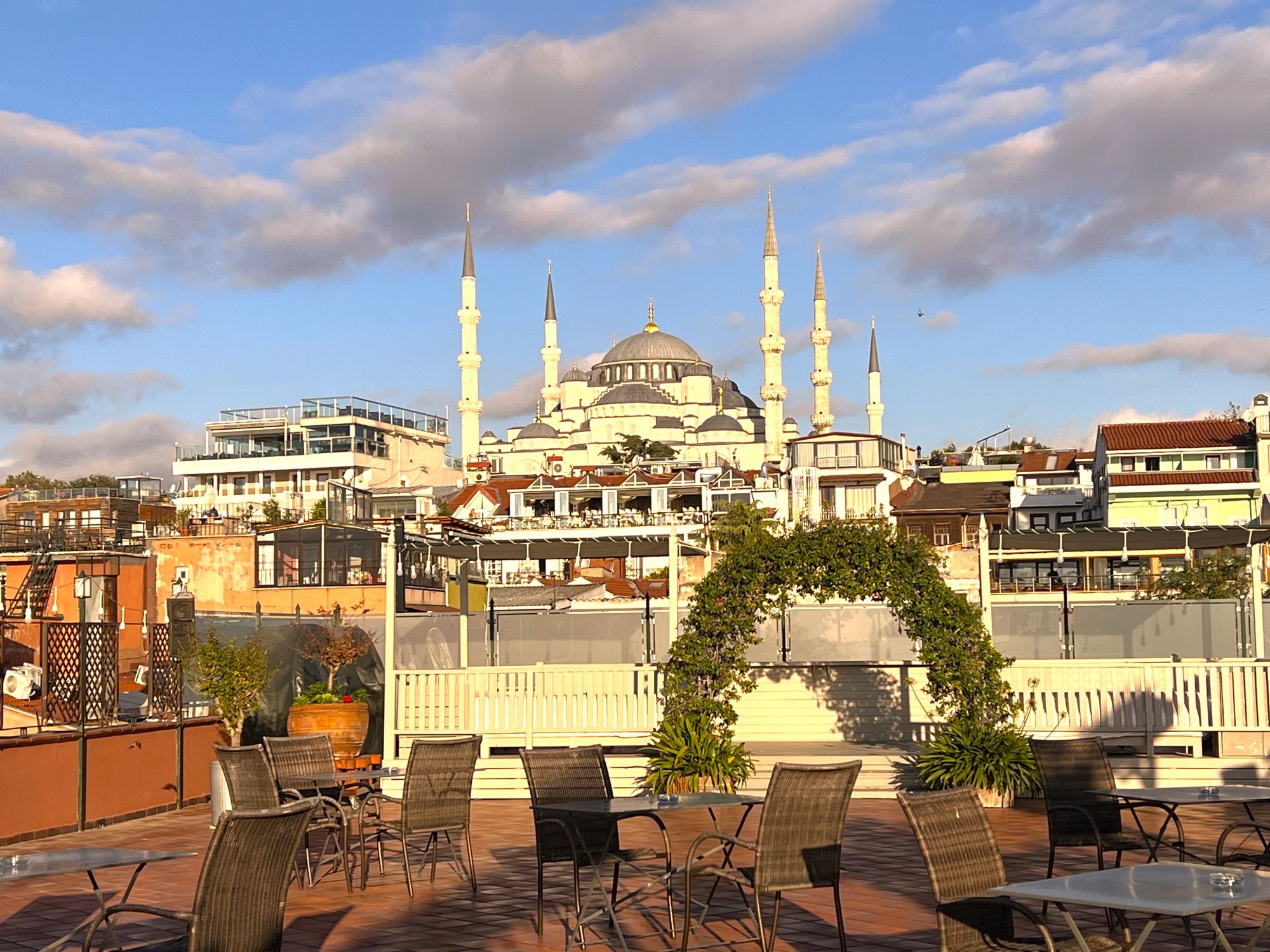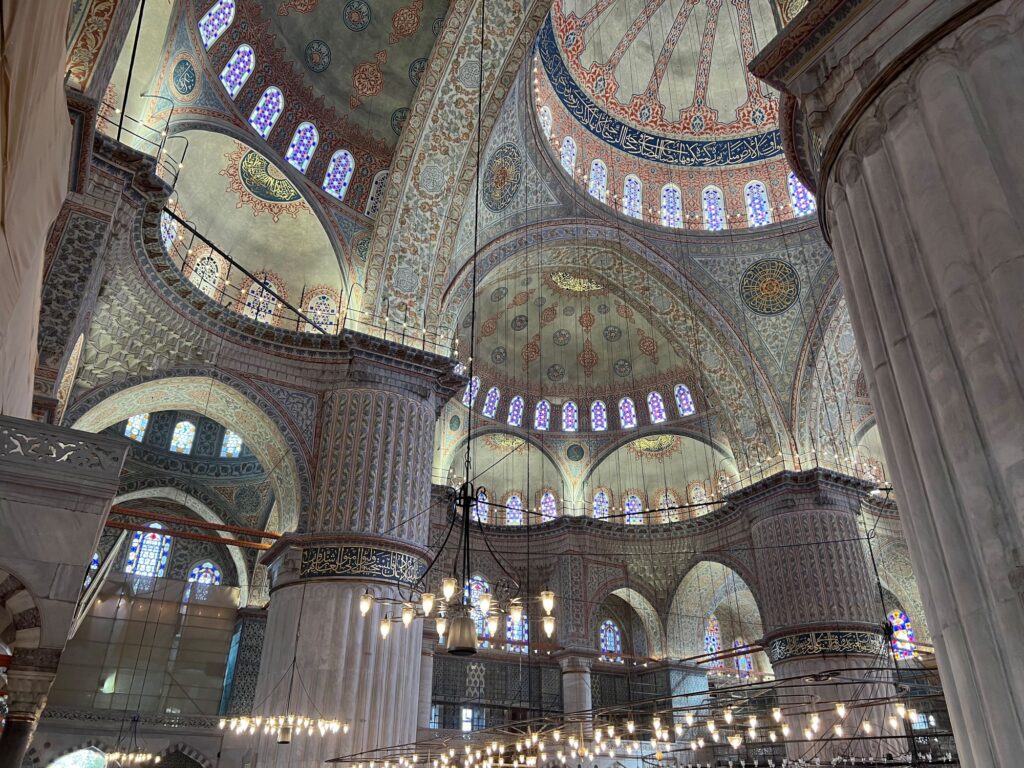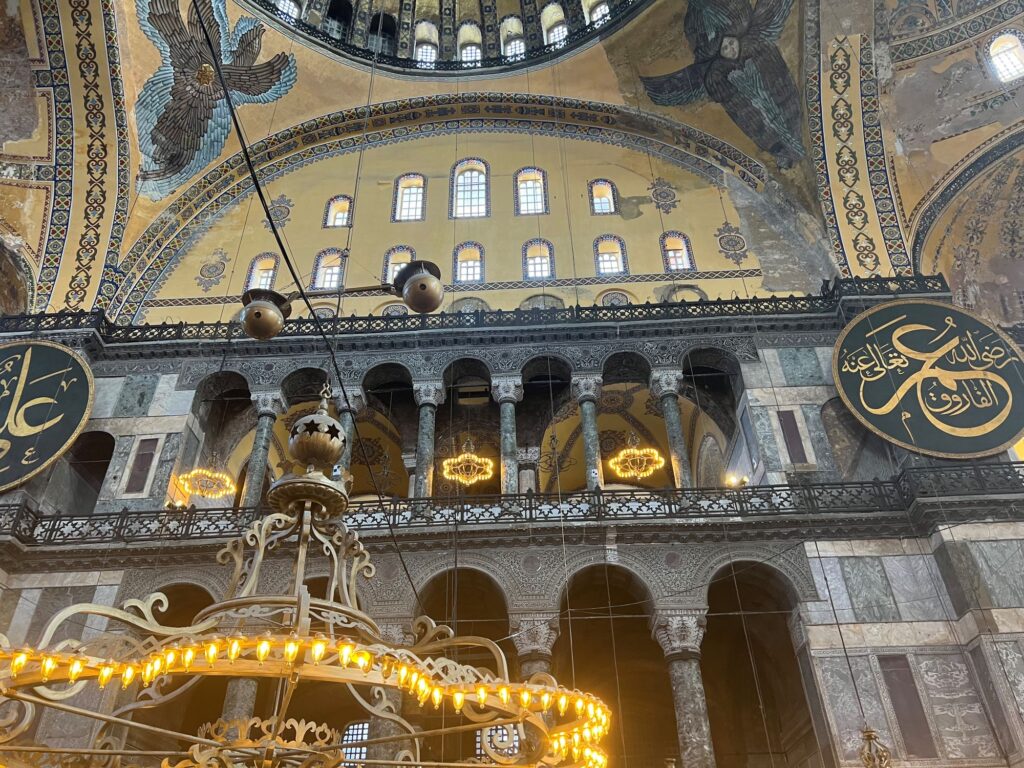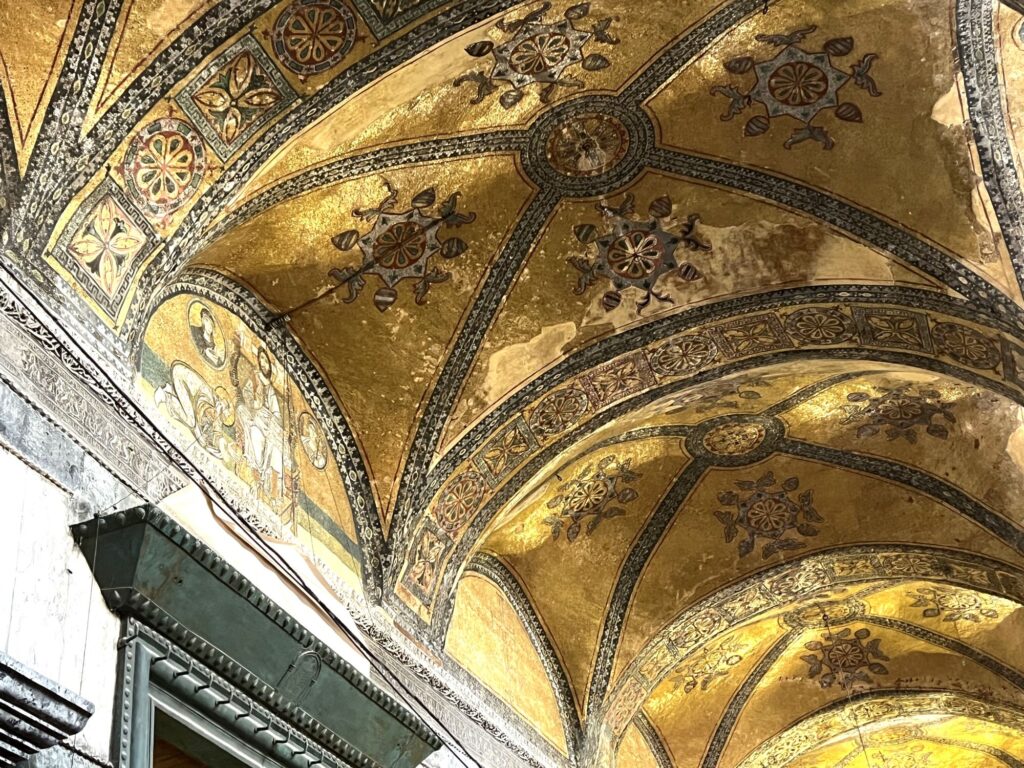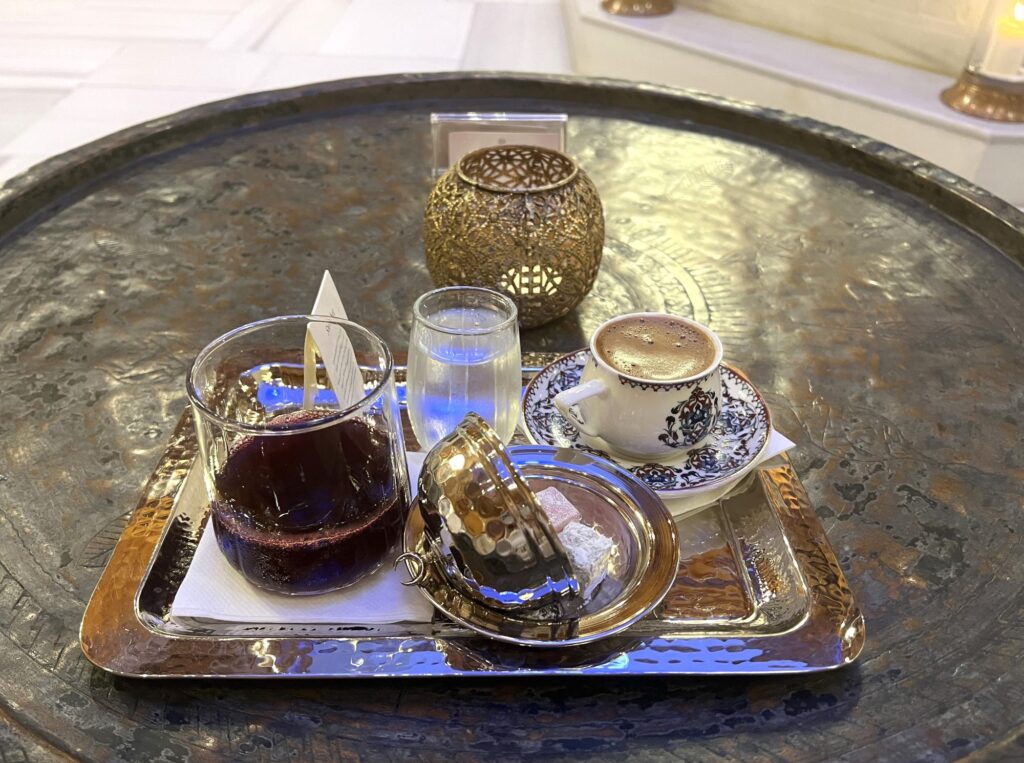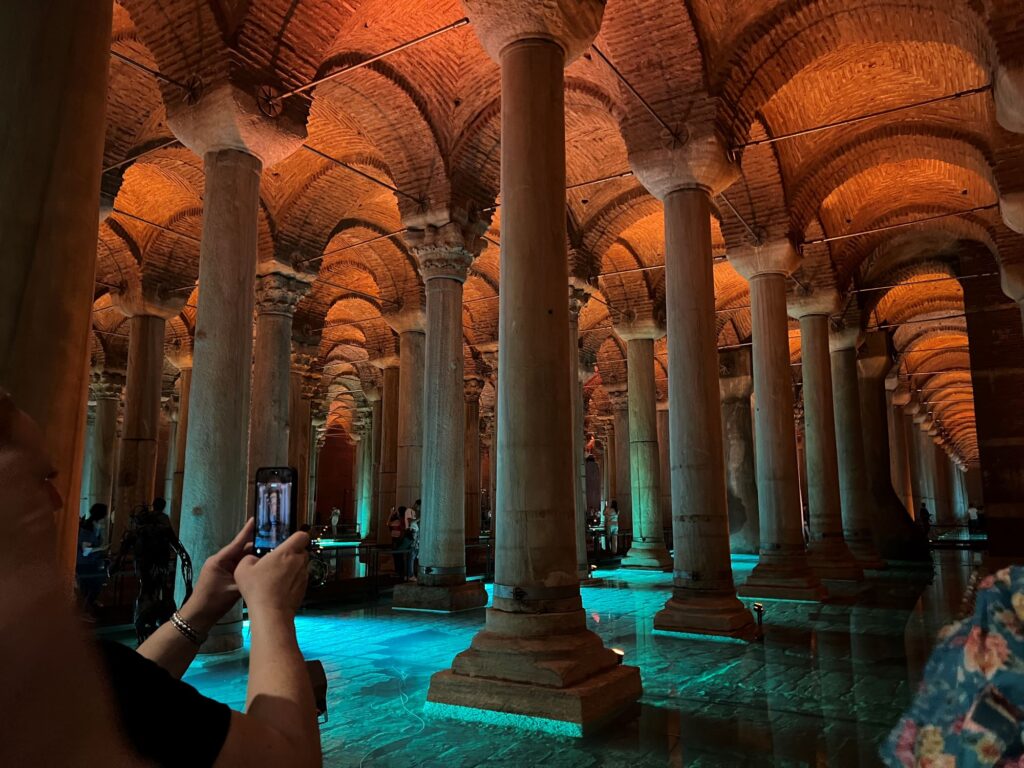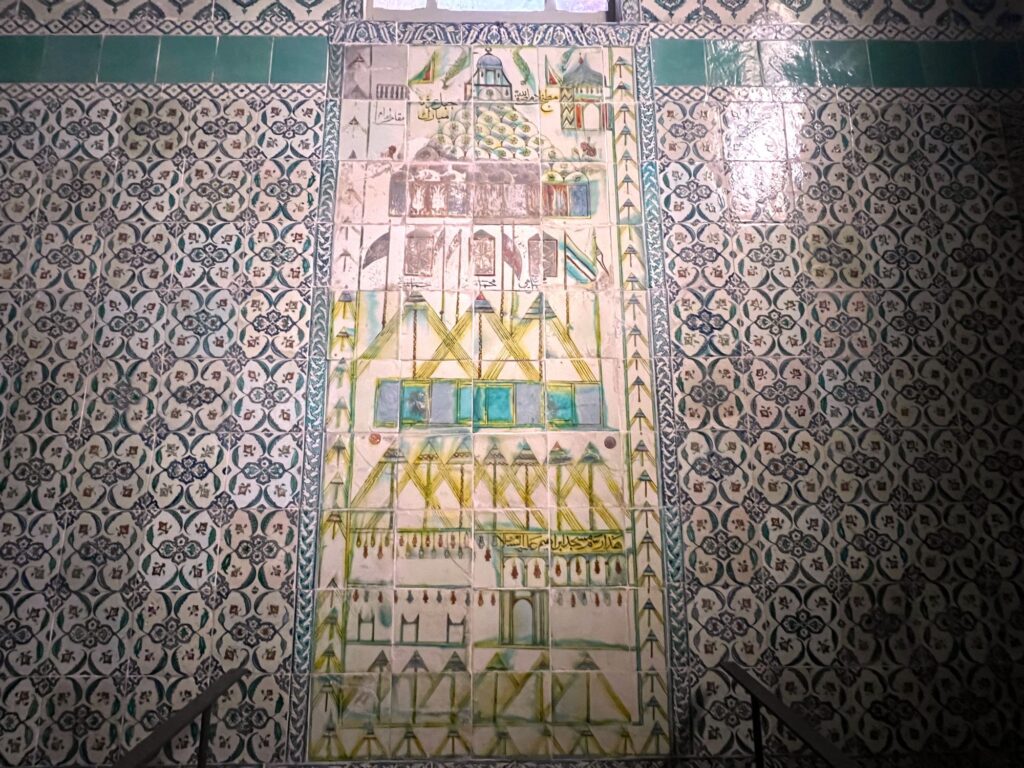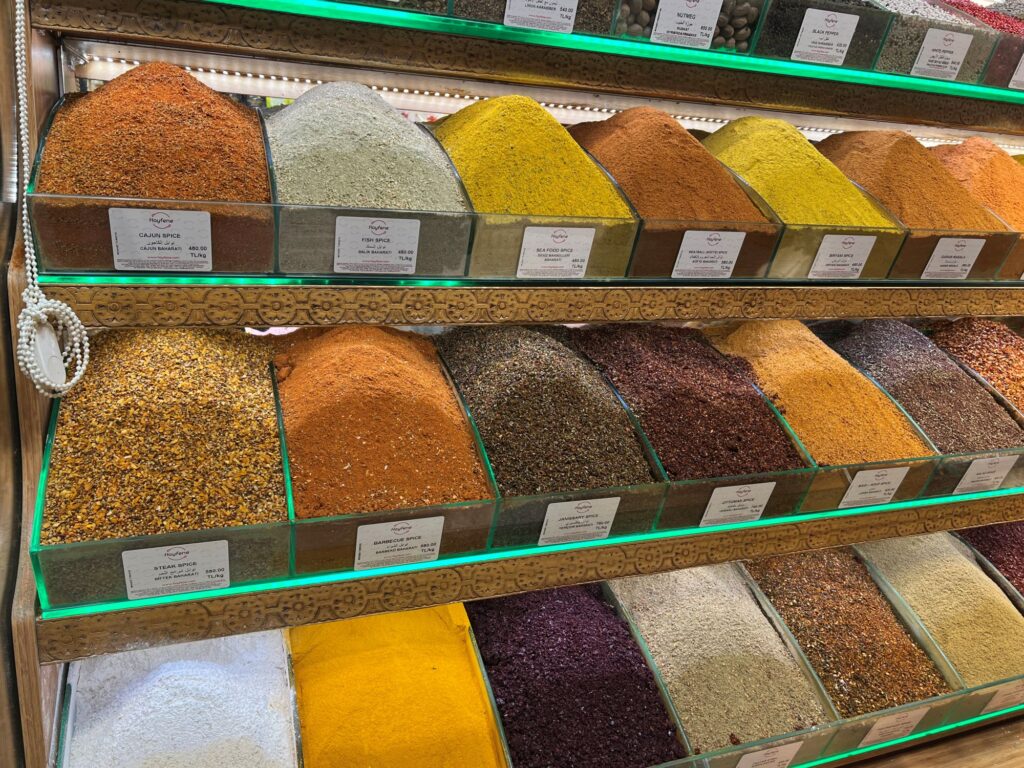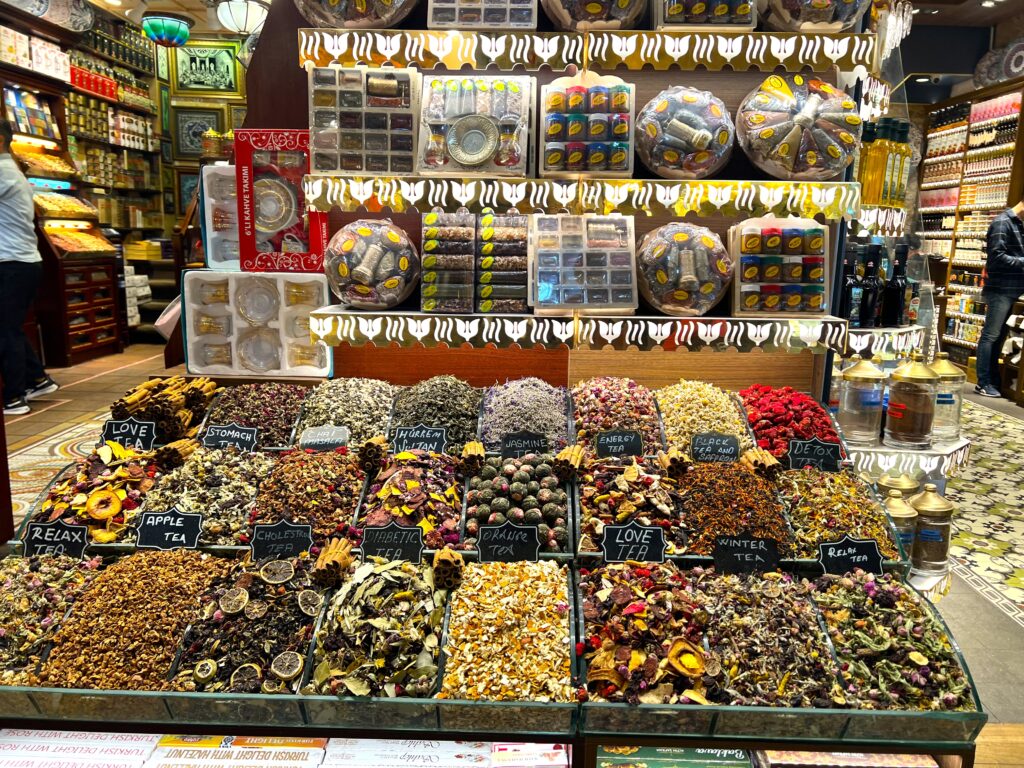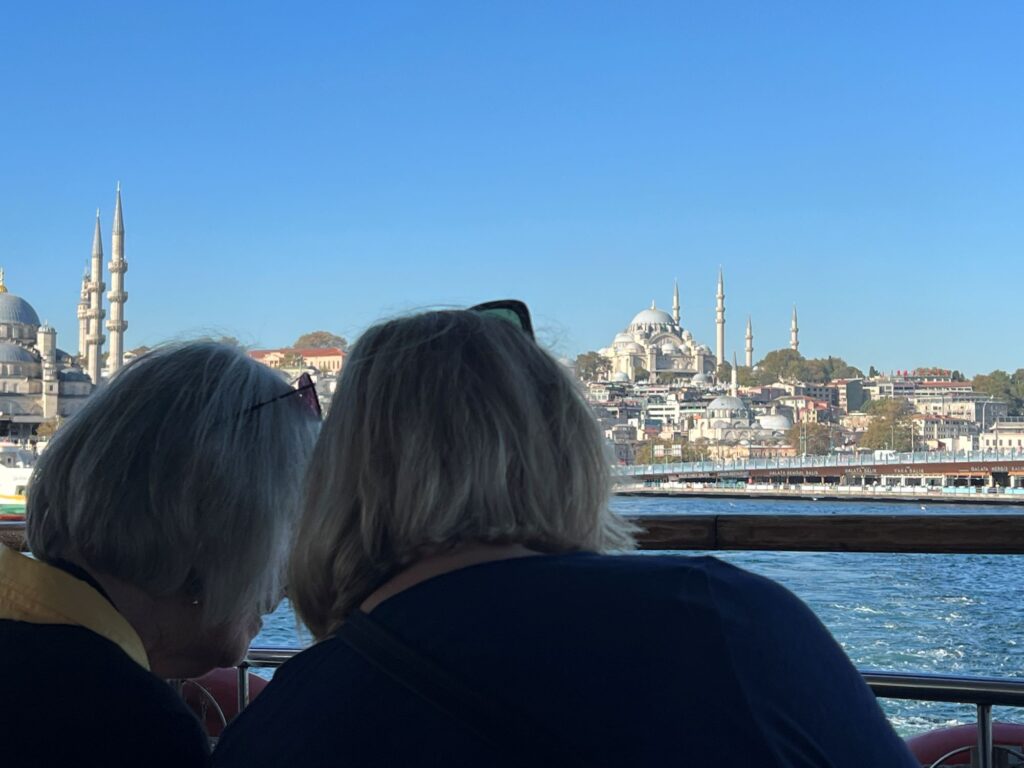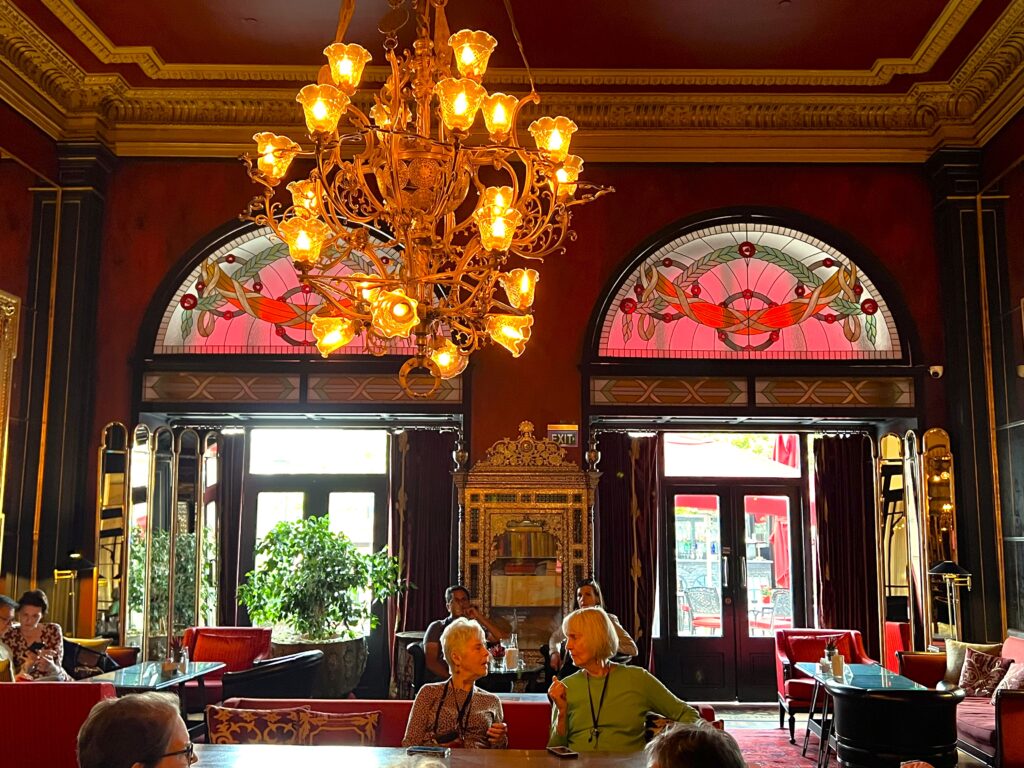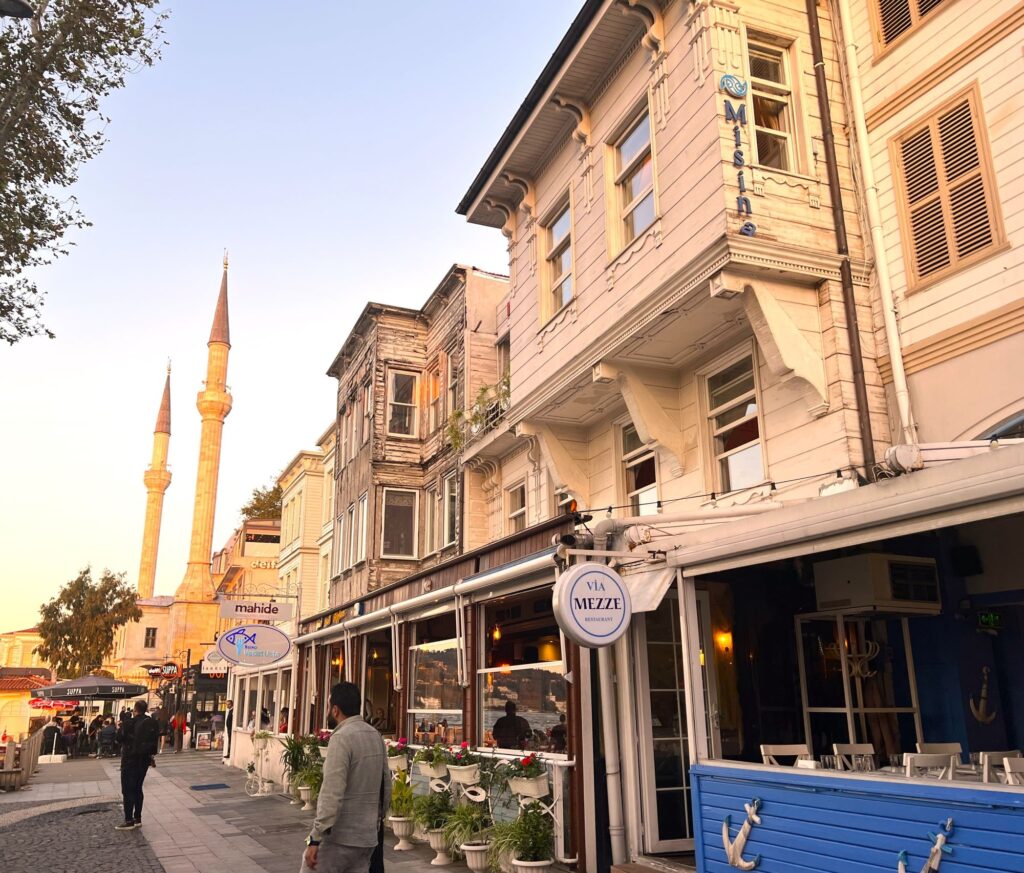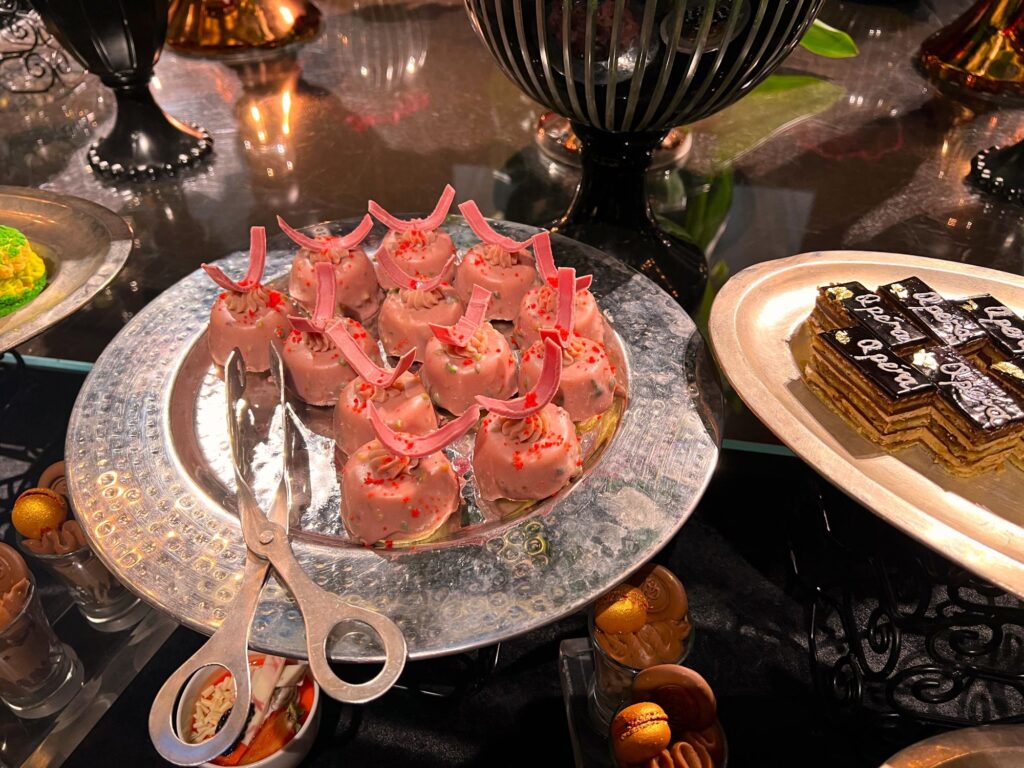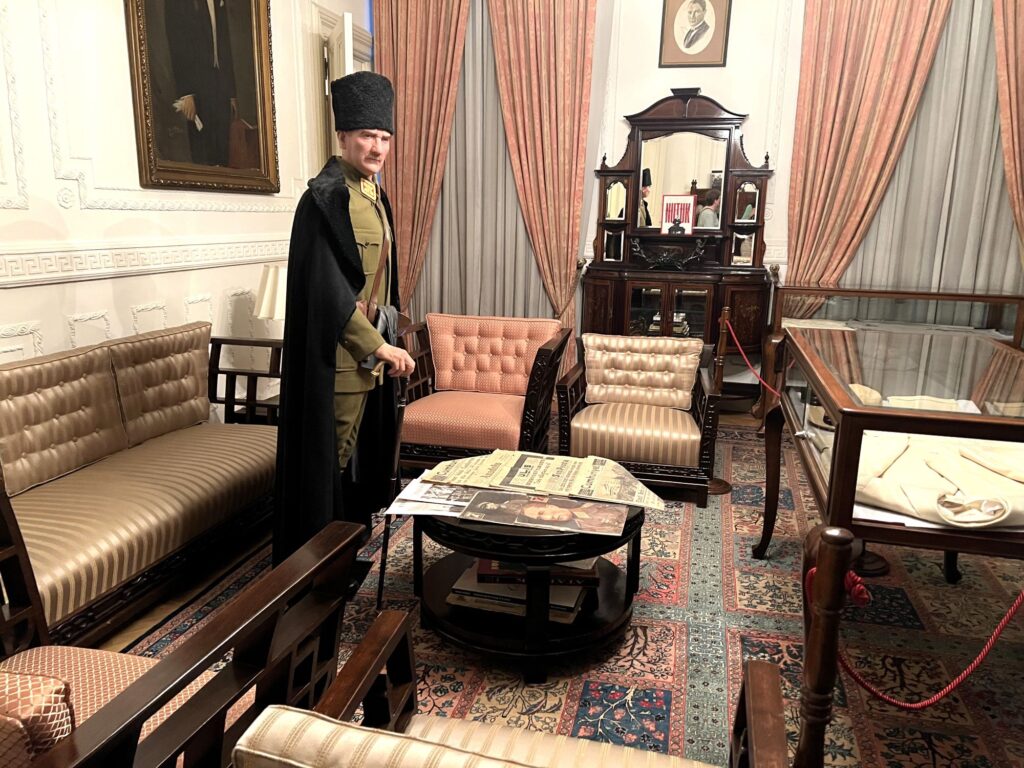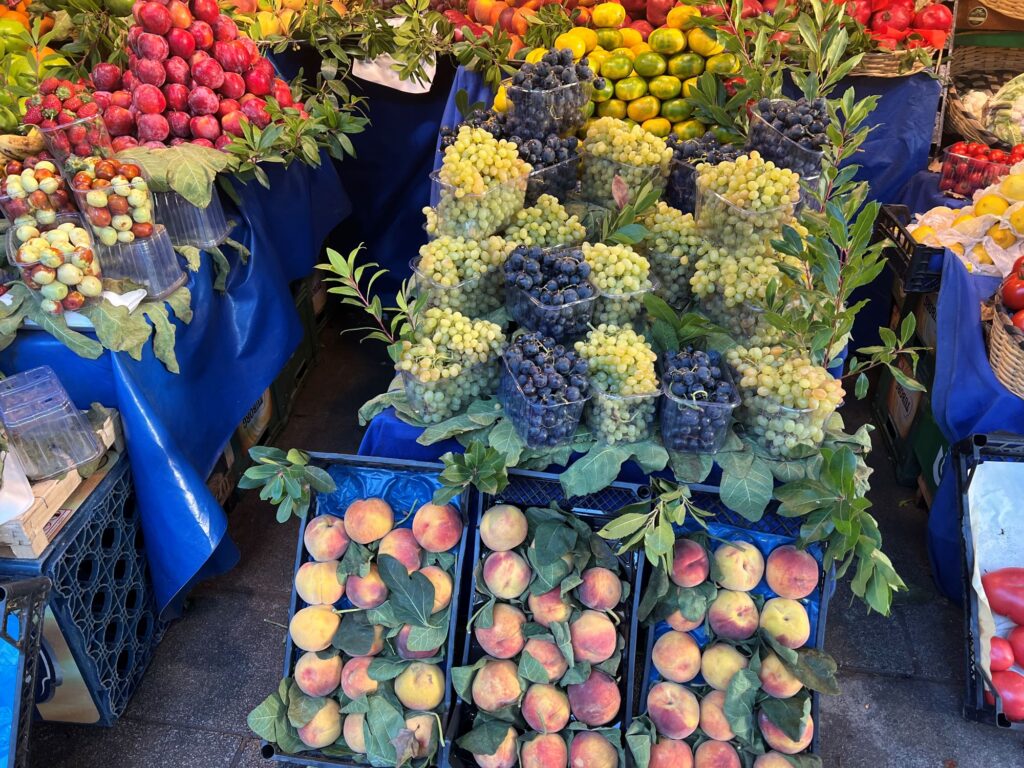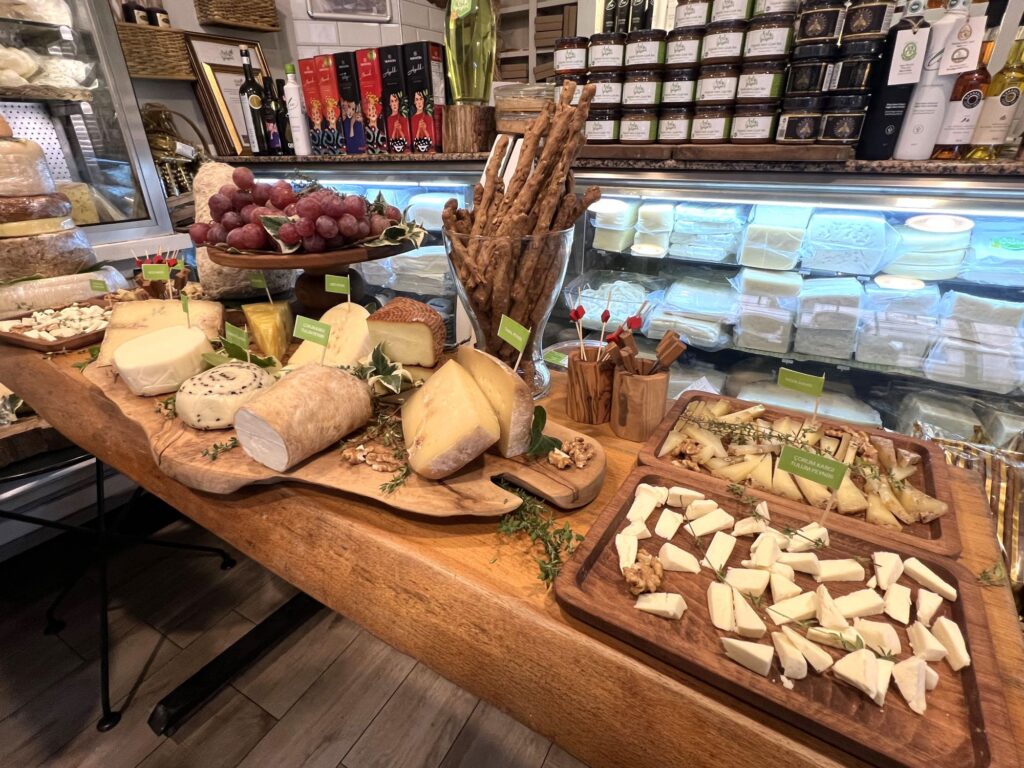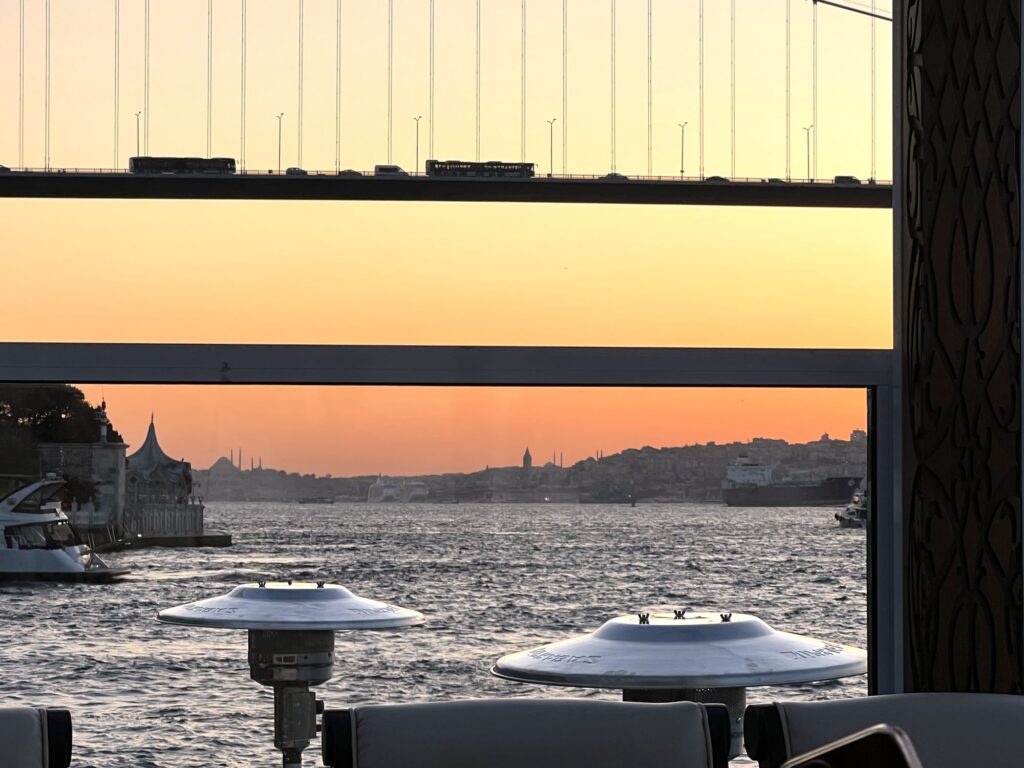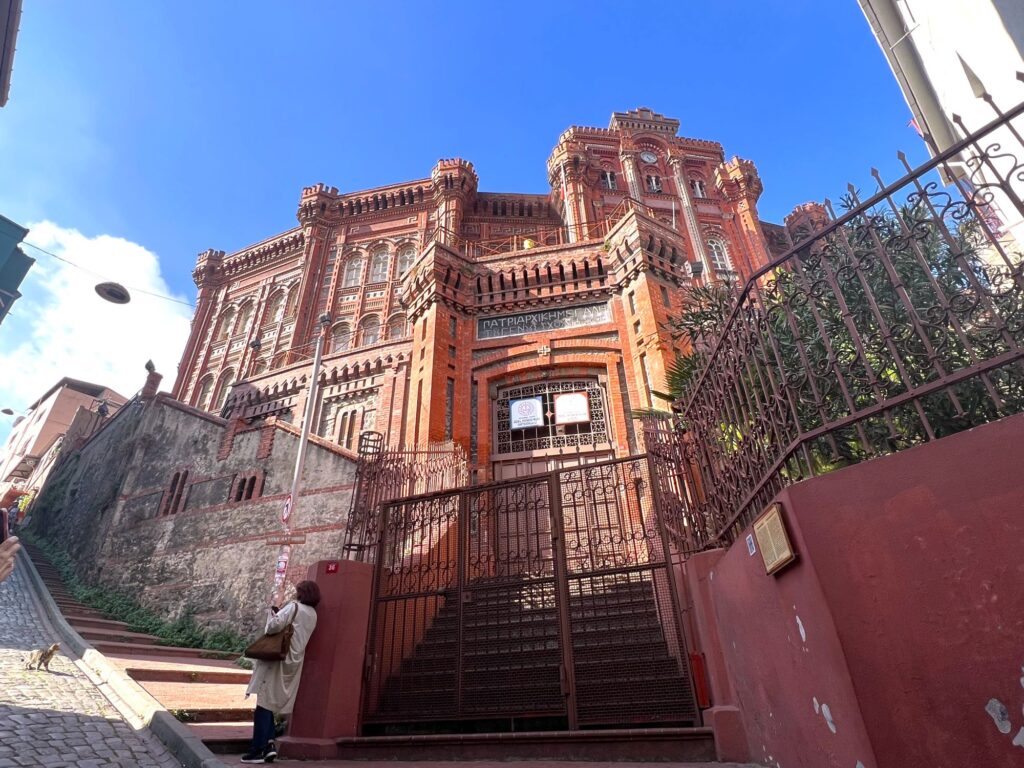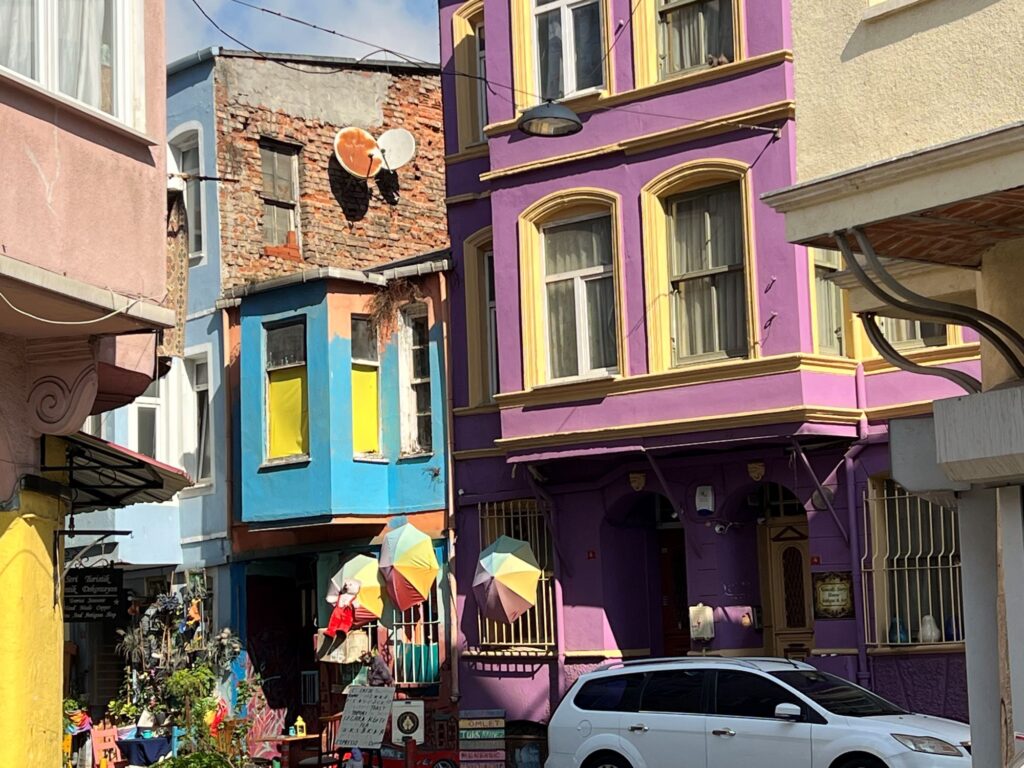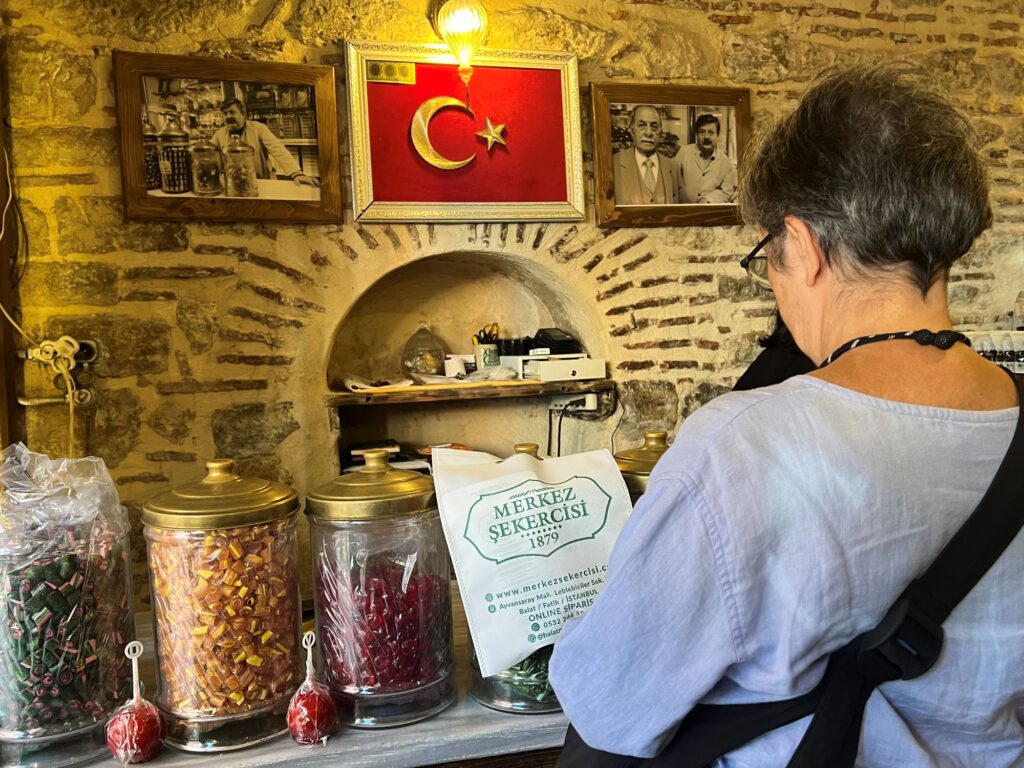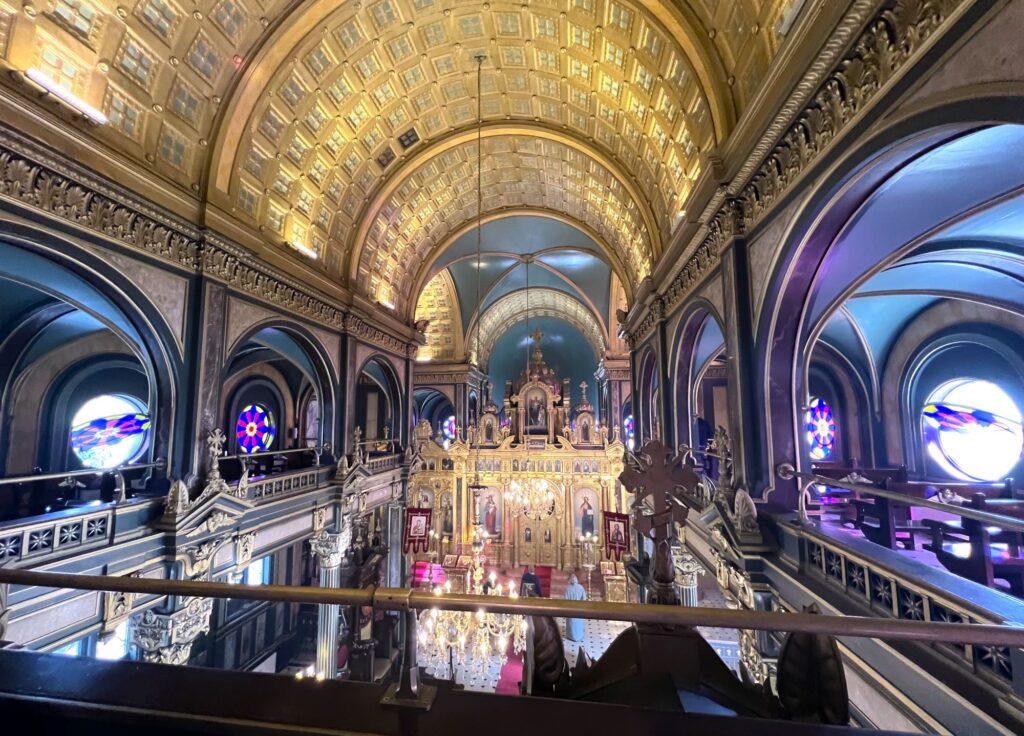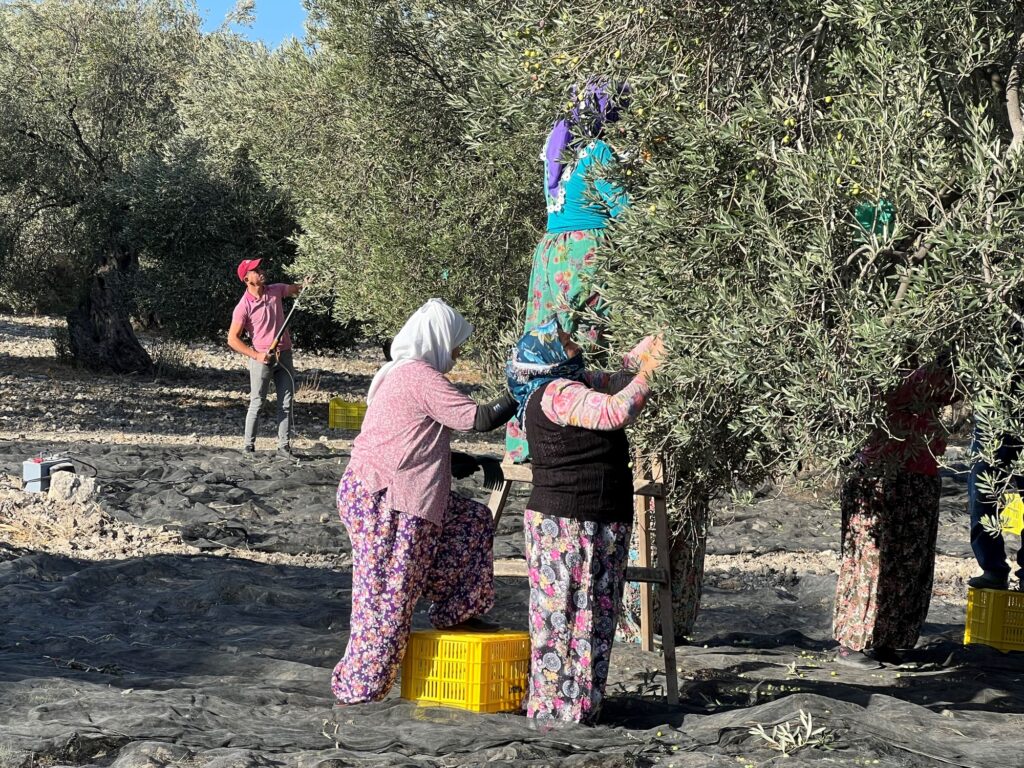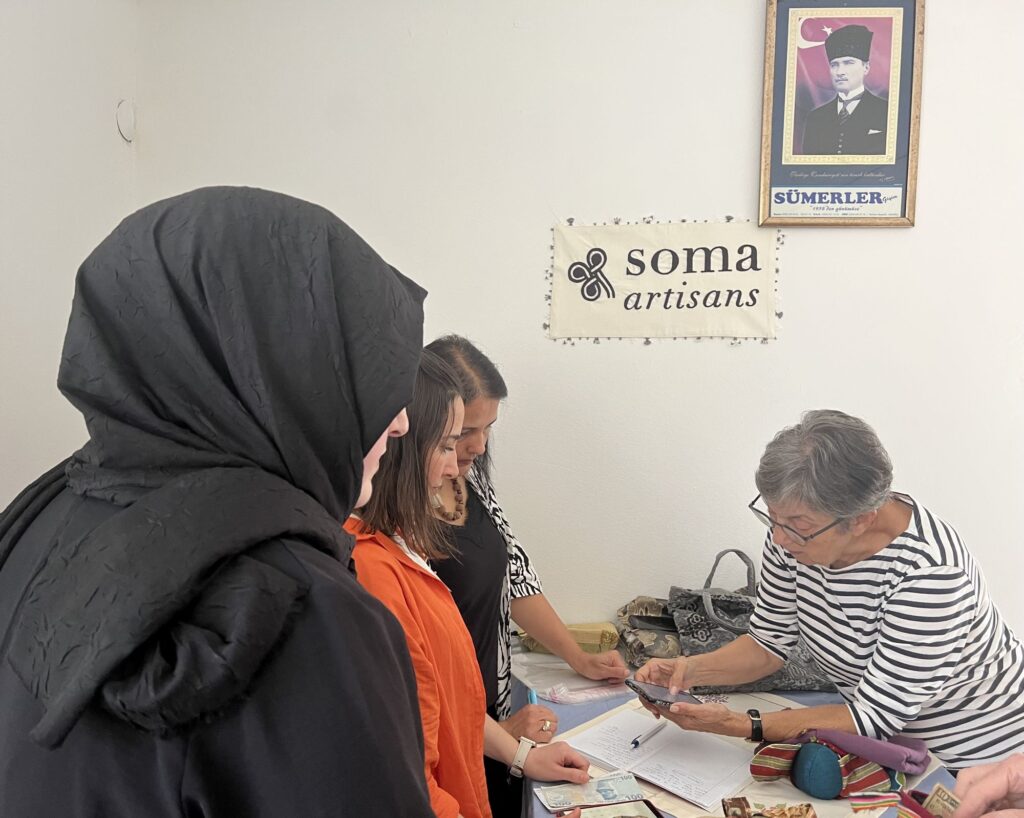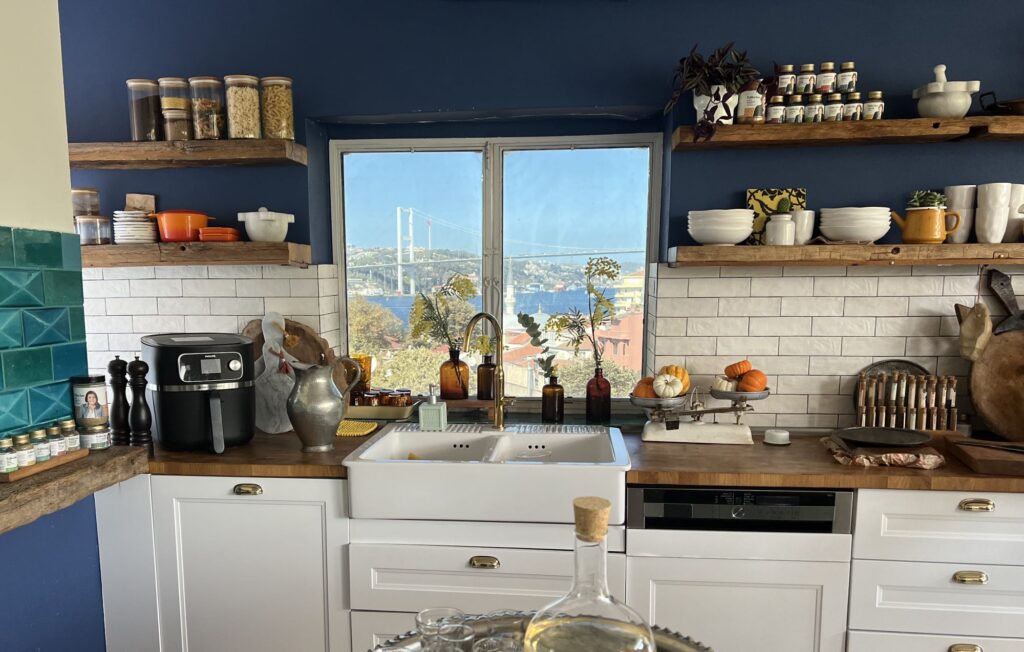Culinary travel is popular in Turkey and for good reason. Its multi-faceted cuisine – which has evolved over 2000 years of migration, invasion and trade – is one of the world’s major cuisines, along with French and Chinese. While many people are more familiar with French Provencal, Greek or North African cooking as “Mediterranean,” in my first experience with Turkish food, as my palate expanded, I found it to be more sophisticated and complex.
Our 10-day trip was sponsored by Anatolian Artisans, a North Bethesda, Maryland-based nonprofit supporting underserved women in Turkey. On the trip, I got to know about 15 other Womantravelers of all ages. Some have been aficionados Turkey since serving there in the Peace Corps in the 1960s, others were Turkish women who live in the U.S. and the rest, like me, mainly first-time explorers to Turkey. Within the group, a few smaller clusters had known each other in advance, but happily all of us individuals were so compatible those connections weren’t necessary for “entry.”
What we all shared was genuine curiosity about this culinary mecca and its origins in history, culture and geography; a non-stop itinerary in Istanbul, one of the world’s most exciting cities, and three days in the agricultural Northern Aegean area around Ayvalik, Turkey’s “olive oil capital.” Our journey was filled with so many new experiences that before writing these articles, I wanted to learn more beyond those initial introductions and have included links to several useful resources if you want to explore further. Meanwhile, be sure to follow @anatolianartisans and others mentioned on Instagram so you learn more about them and take advantage of the next Anatolian Artisans culinary tour.
Brief History and Overview
Originally nomads from central and northeastern Asia, the Turks moved westward to Anatolia, collecting culinary practices and assembling meat, grain and vegetable preparations, enhanced by an extraordinary array of spices, in a signature cuisine rooted in a pastoral culture nd in which legumes are a main protein source. Because of the length and breadth of Ottoman Empire, Turkish ingredients and recipes draw from such diverse regions as the Far East, Persia, Arabia, the Balkans and the Mediterranean. And, Istanbul, historically a magnet for people from all over Turkey looking for work, is its cultural heart, where each region of Turkey and much of the globe are represented in unique ways.
The “shared table” is deeply embedded in the culture. Meals are rarely simple. From “mezze” (small plates) to long tasting menus to multiple courses (and usually both), they represent a wide variety of dishes, and many of which represent a fully balanced diet!
As part of a carefully curated tour, clearly we were introduced to the “best of.” That said, our hosts were determined that we would learn about “real Turkish food” and have truly authentic experiences – whether in popular restaurants, “insider” neighborhood eateries, private homes, confectioneries, markets and even cooking and dining right on the farm. For me, this trip was only a starting point into what I expect will be a much longer exploration into culinary Turkey and its revelations about history and culture.
Our food guide was Hülya Ekşigil (@hulyaeksigil), a friend and colleague of Anatolian Artisans’ founder and president, Yildiz Yagci, a Turkish-American journalist living in the Washington, D.C. area. A longtime editor and writer for several magazines, Hülya contributed to the food pages of Milliyet Sanat Magazine for the last 20 years. She has two books (Dilim Gülümsüyo! and İyi Bir Yemek) on food culture and was the editor of Gökçen Adar ile Mutfakta Dört Mevsim, a two volume-cookbook. She also was the field coordinator of the Istanbul episode of “Food Lover’s Guide to the Planet,” a documentary for Gourmet magazine and broadcast by National Geographic TV, and took part as an Istanbul food guide in the Istanbul episode of “Street Eats-Europe” for the Travel Channel. Hulya has contributed to many books on food culture with her articles on different topics. Her Instagram feed (@hulyaeksigil) has become one of my daily delights for its culinary and insights and photos. For the last 12 years she has been trying to introduce the opulence of Turkish Cuisine to her guests as the food guide of Context Travel company.
Hulya’s selections and connections were stellar. Each location had a personalized touch – perhaps a chef’s presentation, a short lecture by a shop owner, a “walk-around” with Q&A, even cooking classes. Our curiosity as Womantravelers was unlimited, and our hosts were eager to help us on our discoveries. With our Turkish hosts, including the fantastic cultural guide, Nedime Dicle (@nedime.dicle), we gained the equivalent of a semester-long intensive into Turkish history, arts and architecture, urban and rural life and, of course, cuisine at all levels, in just 10 days.
Where to Start?
Note to self: “I am smothered with overstimulation. My senses are running wild.”
I don’t think you can use the word “breathtaking” for Istanbul too many times. To be sure, the traffic, street congestion and lines were annoying. Yet, with the skill of our guides and the expectant spirit of longtime Womantravelers we navigated with relative ease in an exotic, dynamic global city. Who would not do it all over again??
The visual reel unspooled from each bright sunny morning on the roof deck of our delightful Armada Hotel at the foot of the history-drenched bluffs within the tall stone walls of the old city on the European side of Istanbul, up to its two most imposing mosques (Sultan Ahmet Camii – the Blue Mosque – and Hagia Sophia. From the 15th century, a half turn positions us for a sweeping panorama across the Sea of Marmara to the bustling Galaport area and miles and miles of hilly, urban Istanbul. Beyond, past the international waters of the Bosporus Strait to the Asian side, hidden neighborhoods of a quaint character and cozy with cypress, linden and sycamore trees would beckon us in the coming days.
Each morning during our seven days in Istanbul, we started with a “typical Turkish breakfast” just inside the roof deck. Think “banquet spread,” which in my regular daily life, would feed me until the evening meal. Breakfast was a sumptuous feast across the long table filled with black and green olives, yogurt (with grape molasses and nuts for toppings), farm-fresh arugula, cucumbers and tomatoes, cheeses, cured meats, eggs, fresh-baked bread, fruits, preserves and jam, honey, pastries, sweet butter and other dips and sauces. I’m sure I’ve left out something. My “core” starter of the day quickly centered on yogurt, drizzled with grape molasses and sprinkled with sunflower seeds, a small bundle of Turkish string cheese and chunks of other cheeses, the freshest arugula and parsley on the side, perhaps with tomato, followed by an egg dish and usually a pastry (or two, hmmm).
Purposefully situated Mosques appear at every degree around the hills of Istanbul, both on the Europe and Asian sides. Calls to prayer ring the air five times a day, something I became used to years ago in Morocco, but do not interrupt the steady bustle of this very crowded global city of 18 million people. Its views in any direction are breathtakingly beautiful, often capturing intricately designed old wooden and stone Ottoman mansions and palaces, extremely tall skyscrapers and remains of ancient citadels, fishermen and ferries, sunrises and sunsets over the line of hills leading down to the inland Sea of Marmara and the international waters through the Strait of Bosporus to the Black Sea. The new airport is an hour’s drive (40 minutes without traffic) and some of the restaurants and neighborhoods we visited took an hour by bus through the slow-moving, bumper to bumper maze of people, cars, trolleys, buses and surface metro system.
When I close my eyes, I visualize Istanbul as a bracelet of charms connected by streets, bridges, ferries and the light rail in all directions. It reminds me of San Francisco, densely populated across hills down to the shoreline, with movement around and across determined by waterways, but unlike San Francisco, there is no respite from buildings due to mountains and unbuildable hilltops. Each charm on this bracelet has its own characteristics – perhaps as a neighborhood, streetscape, museum or monument, market, seaside port or religious center. “Thrilling” is an immediate sensation, a crossroads of all significant ancient cultures, setting of empires that have reordered world history, high energy amalgam of East and West today and scene of extraordinary cultural diversity reflected in the culinary significance of its food.
The old neighborhoods have cobblestone streets, pavers and windows with iron bars. These streets are so narrow that you have to leap to the sidewalk to prevent injury when cars sometimes zip by. A clever system of large stones positioned low and systematically along the curbs prevent cars from jumping the curb to park half on the sidewalk. There’s a feeling of everything fighting for street space, people, cars, and of course, cats. In the ‘50s, many of these streets were covered by asphalt for modernization, yet the prevalence of cobblestones and pavers in the historic sections often meant a challenging “hike” and constant test of balance.
Selected Highlights of Our Journey
“The whole world thinks that this city is the most beautiful place on earth.” Edmondo De Amicis, 19th century Italian novelist
There is so much to take in, that I’ll be processing it for weeks and months. In this article I’ll provide highlights, the bones of the experience that might help other Womantravelers plan their own adventures. My notes are hardly complete – I was there after all to experience rather than fully record journalistically. Lapsing from the quick-read formula of a blog, there is so much to jot down for my own memories that I’ve broken this journey into several articles and, here, in several topical snapshots. (You may need to use a translator, Google or otherwise, for some of these links. Apologies to the Turkish language, as well, as I am not giving consistently appropriate attention to the special characters of the Turkish alphabet.)
First, a brief primer of common Turkish dishes or ingredients that more or less form a “core” of what you can expect regularly. The diet is grounded in wheat (flour, bulgur, cracked wheat), rice, meat, beans, yogurt, dried fruits and nuts, aromatic spices and olive oil. It’s difficult to reduce the basic dishes to a list, but here is a start that I assembled for myself:
- Kebap (yes, with a “p”) – beef, lamb, chicken or minced cubed or thinly sliced meat fried or grilled
- Tursu – pickled vegetables
- Köfte – meat balls (spiced, formed into rolls and fried)
- Hamsi (anchovy) – fresh favorite from the Black Sea, much different from the tinned anchovies on U.S. grocery shelves
- Eggplant – featured in many dishes
- Dolmas and sarma – vine, cabbage or chard leaves stuffed or wrapped with a mix of minced ground beef, spices, rice and/or bulgur wheat and cooked often in a tomato sauce. Or, they may be vegetarian and feature such ingredients as rice, spices, pine nuts and currants.
- Mezze – small plates
- Desserts – for this nation of sweet tooths/teeth, there are plenty! Chief among them is helva (or halva) – a sugar/starch dish and its tahini helva counterpart (sesame tahini) – both versions with high levels of fats, carbs and a minimum of proteins and, fortunately, often served in smallish (but never tiny) portions. “Turkish Delights,” dense jelly-like candies, are everywhere in just about every flavor (my favorites are rosehip and pistachio).
My favorite restaurants and specialty food shops in Istanbul:
- A typical fish house in the old city, Balikci Sabahattin. It was our first night. I was both starving and spinning! What a lively atmosphere, with every table packed through the wandering rooms of the old mansion. I counted more than eight courses and fish preparations, including bonito, the ancient anglerfish, red mullet, shrimp (with arugula in a salad), baked rice and mussels, anchovies and calamari. Platters piled high kept arriving! Clearly the proprietors kept a close eye on the success of their business as they roamed around, monitored the evening’s progress and greeting their guests.
- Lunch at a famous meatball house, Tarihi Sultanahmet Koftecisi. Köfte are “meatballs,” of which there are a couple hundred versions in Turkey, and they are not necessarily round. This restaurant serves only meatballs as a main course, dressed with a spicy sauce on the side, bean salad and semolina halva (a sugary dessert). We learned that a good meatball is at least 77 percent meat.
- Turkish coffee was served later in the courtyard garden of Yesil Ev, an old mansion turned into a Hilton hotel. Once coffee houses were only for men, by the way. The ultra thick coffee, served with or without sugar, came as a refreshing interlude in the shady garden.
- Dinner at Rejans, a landmark of international gastronomy and intrigue since 1924. Its elegant interiors are reminders of past regular clientele (notorious or otherwise) – Mata Hari, Agatha Christie and Kemal Attaturk. This blogger’s experience captured the scene well.
- Havuzulu Restaurant inside the Grand Bazaar is another restaurant passed on from father to son, in this case for 64 years. Our lunch was home style Turkish food with ingredients that typically fed the people working in the area, or, as described to us, “healthy fast food” of basic greens, grains, meats and rice. I would elevate that description myself. The setting was relaxing, dining not rushed, and the long-cooked green beans in onions and tomatoes and meat-filled wrapped kale leaves (dolmas) were both comforting and delicious.
- Chef Sinem Özler, among the rising female chefs in Turkish cuisine, was recently named to the 2023 Michelin Guide for Seraf Mahmutbey, an upscale and uptown restaurant outside the city’s center. Her focus is seasonal regional Anatolian cuisine, faithful to cooking traditions and distinctive by geography. Cooking many of the dishes in a wood-fired oven, she oversees a kitchen that stays as grounded as possible, and where, for example, ground beef is kneaded by hand and lamb meat is processed in their own butcher shop. Seraf grows its own herbs and favors women producers and works with women’s cooperatives. Plumbs, almonds, apricots, harissa, onion, garlic and tomatoes are some of the many ingredients from sweet to savory that found their way into the meat and bulgur köfte and fish main plates and side dishes prepared for us. The slow-roasted semolina halva for dessert, with plenty of butter and almonds, had been cooked over low heat for four hours. Seraf’s website presents the menus and their details in English.
- At Ciya Sofrasi kebab restaurant in the Kadiköy Market, we sat outdoors and sampled a novel assortment of kebab flavors. The chef owner has been called a “culinary anthropologist” who assembles ingredients from Turkey’s regions, especially from the east and southeast, and has appeared on Chef’s Table. Some journals have called Ciya “the best restaurant in Istanbul” – a tall order but at any rate definitely worth a visit as noted in The New Yorker a few years ago. My plate held juicy kebabs prepared with vibrant flavors – pistachios, ricotta cheese with spicy pepper paste and herbs, a salad with herbs and parsley and dried eggplant dolma.
- Ismet Baba in Kuzguncuk is one of the few “old style meyhanes,” the traditional taverns where friends and families kick back over the national drink raki and share small plates or mezzes. I will admit I’m not a fan of raki, the 80+-proof drink of twice-distilled grapes and aniseed, considered a gesture of hospitality and friendship in Crete, Turkey and the Balkans. On the other hand, the mezzes were yummy – marinated mackerel (salted, dried, washed, pounded and with olive oil), herring in cream, grilled eggplant salad and yogurt with purslane, large flaky calamari lightly fried, and anchovies, the signature fish of Turkey that unlike varieties more familiar in the US resemble small sardines. It was a beautiful night on the water as sunset happened and the Bosporus Bridge was twinkling with lights.
- At Karaköy Lokantası, with both Michelin and Gault-Millau designations, the lively casual/upscale family-run taverna along the Galataport cruise ship docks, several of us joined for a final round of mezze and reminiscence after the others had left. While by now most of the dishes had become familiar menu items, the signature zucchini fritters were a standout, and we almost fought over them!
Important landmarks not to miss
- The Sultanahmet neighborhood in the old city is often the first and sometimes the only visit in Istanbul and fortunately we tackled it the first day, took it in fully and moved on. The neighborhood and its prominent hilltop location holds, among many sites, the two most important mosques – the Blue Mosque and Hagia Sophia. Here are my quick takes (because there are plenty of detailed resources). Built in the 6th century as a Greek Orthodox basilica (as Istanbul was historically Constantinople), Hagia Sophia became a mosque in Ottoman times and was more recently a museum and closed for time; it has been returned to a mosque, despite its unsettling signs of decay and lack of attention to its historical importance and absolute beauty of its intricately designed interior. Pictures tell the story best. The breathtaking Blue Mosque, nicknamed for its blue-like tiles (which are 85 percent quartz) and blue glass in the stain glass windows, is the only historically significant mosque with 6 minarets, although some newer ones have as many as part of what I’m told is a latter-day competition for powerful presences of mosques along the landscape. These are must-sees and it’s useful to read about them in advance so you can truly appreciate their sheer beauty and the many hands who took years to build them. While you are there, be sure to visit the Sunken Palace or underwater cistern, a now eerie and intriguing setting that once was the underwater reservoir of Constantinople dating to the 4th century.
- At the far end of the neighborhood is Topkapi Palace and Harem, where you could spend an entire day but definitely must devote a few hours. You can still imagine the simple sophistication of the early Ottoman fortress, home to the reigning sultan, where nomadic tribes once set up their tents. That said, it’s impossible to imagine the restrictions of the sprawling harem, as women under the sultan’s wife and available at the will of the sultan never left the confines of those walls, despite their beautiful decorative tiles. From these walls came the came the strange, intriguing fantasies (though true) of scheming, ambitious men and women of the 16th to 19th centuries. Chief among them of course were the sultans, who as the tour illustrates, presided on extra-large beds, bore elaborate heavy brocade costumes and opulent jewelry and supped from Chinese Ming Dynasty porcelain pots so detailed in their craftsmanship that they are now carefully guarded in museum cases. It must have been quite a scene. By the way, the kitchens fed 4000 people daily!
- Spice Bazaar (or Egyptian Market). With 84 shops, the large L-shaped building is next to the “new mosque” (Yeni Cami, built in the 17th century) and was built in 1664 as an extension of that complex. We visited one of the stores within – Hayfene. Five generations of one family have operated this shop within the market, its enchanting aromas from the family’s proprietary spice blends are pervasive. After tastings directed by Martin, the owner, I was so overwhelmed by the scents of cinnamon, sumac, dill, oregano, onion and garlic salts, mint, saffron, smoked paprika and more that somehow I ended up with five, quart-size vacuum packed bags of selected spices for red meats, white meats, fish, salads and yogurt, not to mention the beautiful wrapped balls of jasmine tea and two bags of colorful, herbal “sleep and anti-stress” teas (fruit, rosehips, chamomile, hibiscus, etc.). To be honest, the price was right – a fraction of the same to be found in U.S. grocery stores. And there were incentives, e.g., the great buy on saffron, incidentally called “red gold” for a very logical reason – each crocus yields only 3 red or yellow stamens that can be used; everything is handpicked, and it takes 8 hours to yield 5 grams of saffron. Eventually after such enthusiastic shopping during the trip that I had to buy an additional suitcase to transport everything home!
- Pera Palace had seized my imagination since I started watching the Netflix series in preparation for our trip. It’s loaded with historical lore, elegance and romance – Agathie Christie wrote Orient Express here and Kemal Ataturk, who led Turkey’s independence movement in the 1920s, lived there from 1927 to 1936. ”Pera” means “other side” – as the hotel and its district are across the Sea of Marmara from the old city. Some of us opted out of a sightseeing trek in the neighborhood and lightly frolicked in the hotel’s ornate library adjacent its lavish tea room display. The colors and the hand-wrought pastries and platters of fruit were mesmerizing in their sheer beauty. Upstairs, after befriending a member of the hotel reception between peak traffic activities, we rode the ornate elevator or climbed the elegant winding stairway to grab a sneak peak into the legendary Ataturk’s chambers.
- Although the Grand Bazaar is the big draw, we frequented the smaller Arasta Bazaar on Sultanahmet, especially Jennifer’s Hamam for exceptional textiles; the company works with the last of the weaving artisans in Turkey. If you’re lucky, and inquisitive, they’ll take you from the small bazaar showroom a few blocks to the multi-story warehouse, where over tea and informative conversation, you can shop among the grander variety of towels, pashminas and other textiles of cotton, linen and silk.
- We couldn’t pass up the chance for a traditional Turkish bath or massage at Hürrem Sultan Hamamı, located between the Blue Mosque and the Hagia Sophia and near where the Temple of Zeus once stood. Dating back to the 16th century, operational until 1910, later a prison and a carpet exhibition all, the hamam was restored to its classical Ottoman bath style about a decade ago. The experience was simple luxury, beginning with the hospitality of the sunken gathering room with its dramatic stories-high dome casting warm light and water sounds soothing from the ornate marble and gold fountain. After being escorted to private changing areas and enjoying our baths or massages, we relaxed at the end with a refreshing individual tea presentation. This article is a good recap.
Neighborhoods and Ferry Rides
“To savor Istanbul’s back streets, to appreciate the vines and trees that endow its ruins with accidental grace, you must, first and foremost, be a stranger to them.” Orhan Pamuk
- Our Bosphorus Ferry ride began with a snack brought by our hosts – the pretzel like sesame “simit” street food, a nice accompaniment to the glass of Turkish tea served on the Rumeli Kavagi Ferry. Along the shore are stone and timber Ottoman mansions, once summer palaces, built during the 18th and 19th centuries. Pamuk called them “grandhouses, with their narrow high windows, spacious eaves, bay windows, and narrow chimneys”), once secluded from the rest of the city without paved roads or ferries, only accessible by private boat. It’s said that the overhanging second and third story balconies were built for women who could not go out unescorted but who could experience life from their sheltered perches. We pass village after village, once occupied by different ethnic groups, and although these cultures are assimilated now, their original names still identify them, such as the Albanian Village with its cobblestone streets. Our guide said there are 17 ethnic minorities living in Istanbul, not counting the very recent ones such as Afghans.
- In Ermigan, we stop for a delicious soup and sweet dessert (sugar, milk, rice, flour, cornstarch and cinnamon – and a subtle but characteristic flavor that none of us guessed at first, chicken breast!). In chic Bebek, we had coffee at La Sirene along the waterfront accompanied by another special treat primarily of almond and pistachio paste. At Envai, a continuous independent bookstore for more than 50 years, I bought a bracelet of blue glass beads replicating the symbolic “evil eye” to ward off the bad and bring good luck.
- In the lively neighborhood of Cihangir, we sampled a variety of local artisanal cheeses in the Antre Gourmet Store. I was amazed by the variety of sheep, goat and cow cheeses (another research project for the future), and climbed the hilly cobblestone streets of Çukucuma, a neighborhood known for its secondhand and antique stores. One stop was Alaturca House, a spacious townhouse loaded with antiques and collectibles from Turkey and Europe. I fell for a too-expensive wall hanging from Italy with iridescent blue fish streaming in a community. Dinner was extraordinary at Yeni Lokanta, a tiny restaurant routinely recognized as one of the world’s best and noted in Michelin guides. The traditional dishes with a modern twist were definitely memorable – among them, grilled calamari and octopus, zucchini fritters and sauteed liver (which I normally wouldn’t eat but it was mouthwatering), and a chocolate mousse to-die-for dessert.
- Turkey is a coffee nation despite the prevalence of tea, and in the neighborhood of Kadıköy, on the Asian side, we visited a charming old-century coffee house (Sekerci Cafer Erol) and confectionary in the blocks-long open air street market often referred to as the Kadıköy Fish Market. Here we had a Turkish delight tasting – the signature candy made of gel of starch and sugar and flavored with pistachios, hazelnuts, rosewater, mastic gum, lemon, oranges, hazelnuts and other ingredients before having lunch at Ciya Sofrasi (see above).
- On the last day, while several of our contingent had left for the U.S., a few of us ventured to the lesser-known bohemian quarter of Balat with its lively Greenwich Village-style atmosphere of alternative and eccentric shops, distinctive cafes and unique confectioneries. Throughout the district, there are remarkable examples of Orthodox churches (Greek, Armenian and Bulgarian) and Jewish synagogues, and you can see across the Golden Horn to beautiful mansions and boat houses. Along the water too is the Bulgarian Orthodox Church, built piece by piece in iron from Vienna; it is said to be the only example of a surviving iron church (from 1870) with colorfully painted panels that look like wood but are actually iron. We climbed the steep San Francisco-style hill to walk around a landmark known as the “Red Castle” on the Istanbul horizon, the Phanar Greek Orthodox College, a phenomenal landmark sprawling across the hilltop and often called the “fifth largest castle in Europe.”
NEXT – Going southwest in Anatolia to a culinary tour in the Aegean Region.
